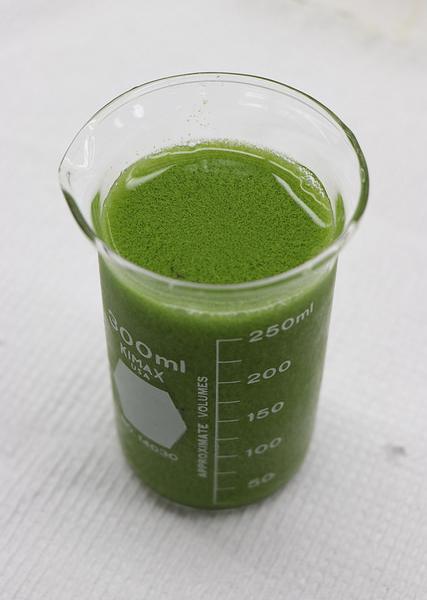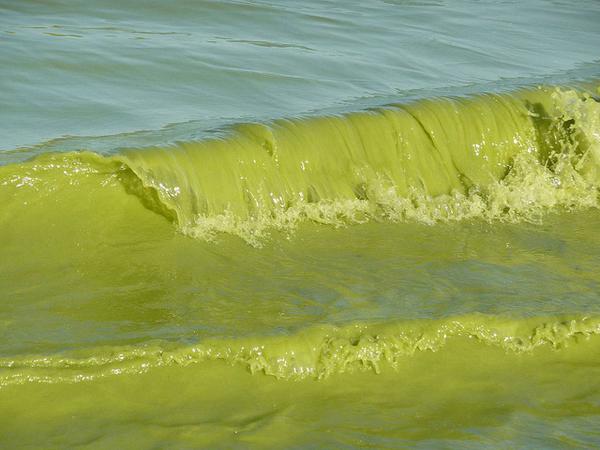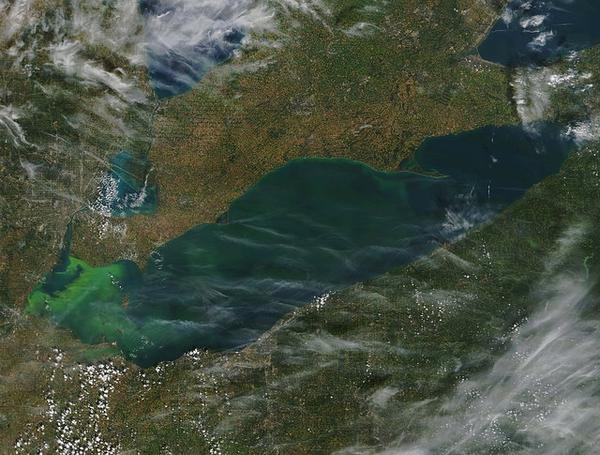
15 November 2017
There’s something wrong with Lake Erie. Every summer when the water heats up it turns a thick soupy green, especially at the western end from Toledo to Sandusky and Point Pelee, Ontario.
The waves look like this or even worse.

The green is not good. It’s caused by Microcystis algae which produces toxins that kill fish and harm humans. The algal bloom was so bad in 2014 that the Toledo Water Authority told their 500,000 customers not to drink the water and not to wash dishes with it.
The bloom reaches it peak in autumn. You can see the green muck from outer space in this satellite photo from September.

The algal blooms are triggered by warm water containing excessive nutrients: nitrogen from sewage and/or phosphates from fertilizer. In this century the water is warmer and it contains a lot of phosphorus flushed into the lake by heavy rain. Cleveland.com explains that “The Maumee River contributes half of all phosphorus in the lake, with about 85 percent of it from fertilizer runoff.” (The Maumee enters the lake at Toldeo.)
We know how to fix this problem. We’ve done it before.
Back in 1969 Lake Erie was plagued by pollution, toxic algal blooms and dead fish. One of its tributaries, the Cuyahoga River, caught fire in Cleveland. Thanks to the Clean Water Act and the EPA established by President Nixon, Lake Erie was cleaned up quickly and stayed that way for 30 years.
Now the lake is in trouble again. Michigan has already declared the lake impaired but Ohio officials are hesitating to do so because “they don’t want to scare away swimmers and boaters.” Meanwhile people see and smell the algae and they’re already staying away.
This 2013 video from KQED tells the story.
video by KQED on YouTube
(photos by NOAA Great Lakes Environmental Research Lab on Flickr; video by KQED on YouTube; click on the captions to see the originals)
Humm…officials in Ohio are reluctant to warn the public about the water because they don’t want to scare people away….In North Carolina, when researchers discovered the deadly Pfiesteria they also did everything they could to keep the scientist who discovered this from publishing her work or notifying the public. They did not want to impact the local economy by protecting people. You can read more about the organism here:
https://academic.oup.com/bioscience/article/51/10/827/245234
Or, for a less scientific read, Rodney Barker wrote about the truth of the entire matter in the book ‘And the Waters Turned to Blood’ (available in paperback from your favorite book outlet).
The book The Death and Life of the Great Lakes is a very good read if you are interested in the lakes.
So sad. I had an aunt and uncle who had beachfront property on Lake Erie, and my brother and I spent hours every day playing on the beach and swimming in the lake. Now, green waves. Ewww.
News of Ohio’s response to lake algae from the Columbus Dispatch: http://www.dispatch.com/news/20171119/state-canada-release-plan-to-cut-toxic-lake-erie-algae-blooms-by-40-percent